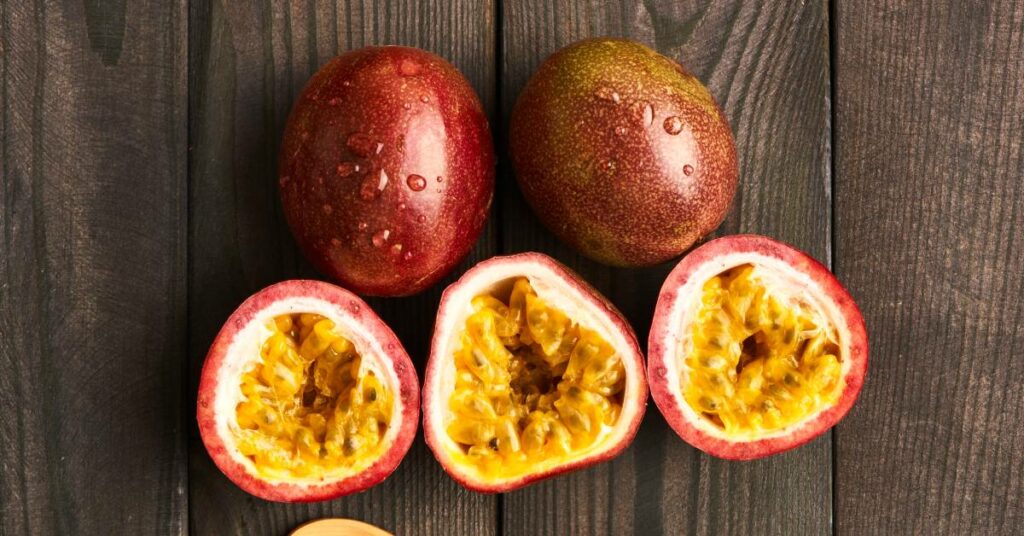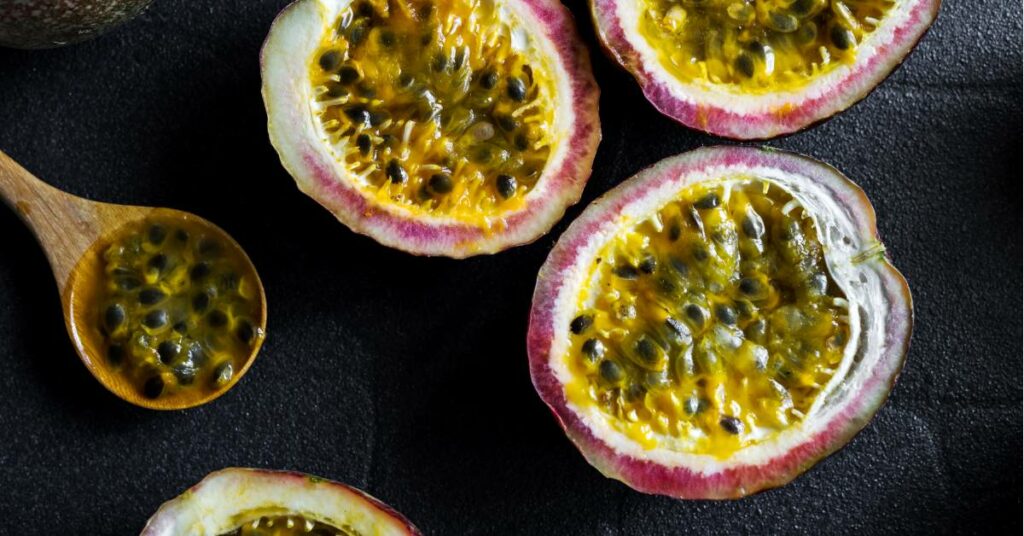Share the post "What Does Passion Fruit Taste Like? (Know the Benefits and How to Eat)"
If you ever wonder, “what does passion fruit taste like?” you’re not alone, as this strange-looking fruit has attracted the attention of most of us lately. And the answer to the query is,
Passion fruit is a sour and tangy tropical fruit that’s refreshing in taste. The seeds of this delicious treat are also tart, while its sweet-tang aroma makes it reminiscent of other fruits such as kiwis or pineapples.
While some love its zingy flavor and refreshing aroma, others devour it for its many health benefits. Passion fruit (Passiflora edulis) has complex flavors and textures. It originated in southern Brazil and northern Argentina, according to research.
Interestingly, passion fruit is getting popular among chefs and food enthusiasts due to its enormous food applications and uses.
Passion fruit is a win-win in all things food, from savory dishes to sweet desserts and tangy dips to refreshing drinks; passion fruit is a win-win in all kinds of food!
This article will walk you through the ins and outs of passion fruit and how you can incorporate passion fruit into your diet.
Let’s dig into the article!

What Do Passion Fruits Look and Taste Like?
Although there are many passion fruits, the most common variety has a purple round exterior. The shape of passion fruit may vary from round to oval, depending on the type. The rind has a waxy texture that wrinkles as the passion fruit ripens.
The interior consists of a juicy-gooey mixture of orange-colored pulp and several tiny black edible seeds.
The second most common passion fruit variety is yellow, that’s oval and comes with a bigger fruit. They are also known as golden passion fruits.
Passion fruit offers a sweet-tangy flavor reminiscent of other tropical fruits like kiwi and pineapples. It’s fruity, aromatic, and pleasantly refreshing in taste. The seeds of passion fruit are tangy in flavor.
Health Benefits of Passion Fruit
Passion fruit offers a myriad of health benefits owing to its antioxidant-rich nature. Following are the health benefits of passion fruits:
- It has high levels of vitamin A, which boosts vision and the immune system.
- It’s rich in vitamin C, which acts as an antioxidant to prevent harmful free radicals in the body.
- The pulp is high in fiber which is crucial for regulating the digestive system and keeping a healthy gut.
- Passion fruit has a low glycemic index value. This helps prevent a steep rise in blood sugar levels, making it suitable for health and an excellent option for diabetic individuals.
- Passion fruit helps improve insulin sensitivity which helps in reducing the risk of diabetes.
- Passion fruit is also linked to improving metabolism in animal studies.
- Passion fruit is rich in vitamin C, which helps the body absorb more iron from food and might help boost the immune system.
Can You Eat Passion Fruit Seeds?
Definitely, passion fruit seeds are safe to consume. They offer a tangy flavor and a crunchy texture that makes them the fruit star. Some people tend to bite them while others simply swallow them whole.
The best part, these seeds are rich in fiber and can potentially help in digestion if consumed in moderation.
The seeds and pulp are mostly used in drinks. However, you can incorporate them in puddings, cakes, and tarts.
LEARN MORE: Can Babies Eat Dragon Fruit?
How to Store and Eat Passion Fruit
You can easily store whole passion fruit at room temperature for up to 2 weeks. However, it can be kept in the fridge for 1 month if stored in an airtight plastic bag or box.
However, the sliced passion fruit can stay fresh in the refrigerator for 2 days.
Alternatively, you can freeze the pulp for longer shelf life. For example, scoop out the passion fruit pulp and freeze it in ice cube trays. The frozen pulp can be shifted to an airtight container or plastic bag, which can stay in the freezer for up to 3 months.
It is cut into two halves to eat passion fruit, and the pulp is scooped out from each half. Although the passion fruit seeds are edible, they can be sieved out from the pulp using a strainer.
Although this fruit is quite popular in drinks like juices, mocktails, cocktails, and smoothies, there are a thousand ways to use passionfruit in recipes. It’s widely used to make salad dressings, dips, sauces, and marinades.
Passionfruit sauce is particularly served alongside seafood and other proteins. Passionfruit pairs well with citrus fruits, coconut, mango, pineapples, strawberries, and other tropical fruits.
Moreover, it can be baked into a cake, muffin, pie, tart, or cooked into custard, pudding, jam, and jellies.
Where Can I Find Passion Fruit?

Passion fruit naturally grows in the Americas, including Brazil, Paraguay, Northern Argentina, California, Florida, and Hawaii.
However, you can find it in supermarkets or specialty stores. You’ll probably find it under the label “parcha” or “maracuya” in the Latin and Caribbean stores.
If you’re unable to find fresh fruit, you can always look out for passion fruit juice or concentrate in either the juice aisle or freezer section of the grocery store.
Moreover, you can find passion fruit jam in the breakfast aisle and passion fruit oil in the oils aisle.
For the passion fruit ice cream, look into the freezer section, while you can find passion fruit wine in the wine aisle of supermarkets.
If for some reason, you’re unable to find passion fruit in the grocery store, you can always order some online.
Conclusion
Passion fruit is a sour-sweet fruit with a juicy-gelatinous interior that’s embedded with edible seeds. This tropical fruit is rich in vitamins, and antioxidants that can support health.
Whole passion fruits can be stored at room temperature for 2 weeks, while they can be kept in the fridge for up to 1 month. You can freeze them to make them last longer for up to 3 months.
Passion fruit can be eaten out of hand, in juice form, or can be turned into an array of sweet and savory recipes.
Find passion fruits in the Caribbean specialty stores. You can most likely find passion fruit juice or concentrate in the juice aisle or the freezer section of the grocery store.
Now that you know what passion fruit tastes like, we believe you’d love to give it try!

